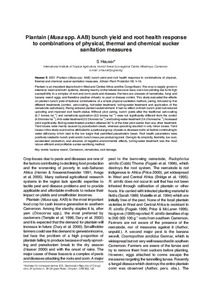| dc.contributor.author | Hauser, S. |
| dc.date.accessioned | 2019-12-04T11:19:32Z |
| dc.date.available | 2019-12-04T11:19:32Z |
| dc.date.issued | 2007 |
| dc.identifier.citation | Hauser, S. (2007). Plantain (Musa spp. AAB) bunch yield and root health response to combinations of physical, thermal and chemical sucker sanitation measures. African Plant Protection, 13(1), 1-15. |
| dc.identifier.uri | https://hdl.handle.net/20.500.12478/3485 |
| dc.description.abstract | Plantain is an important staple food in West and Central Africa and the Congo Basin. The crop is largely grown in extensive 'slash and burn' systems, drawing heavily on the natural resource base, but is low-yielding due to its high susceptibility to a complex of root and corm pests and diseases. Farmers are unaware of nematodes, fungi and banana weevil eggs, and therefore practise virtually no pest or disease control. This study evaluated the effects on plantain bunch yield of factorial combinations of a simple physical sanitation method, paring, followed by five different treatments (control, ash-coating, hot-water treatment, boiling-water treatment and application of the nematicide carbofuran). Paring reduced plantain establishment. It had no effect on fresh bunch yield but reduced uprooting and improved root health status. Without prior paring, bunch yields after the traditional ash-coating (5.7 tonnes ha-1) and nematicide application (6.3 tonnes ha-1) were not significantly different from the control (4.6 tonnes ha-1). Hot-water treatment (12.0 tonnes ha-1) and boiling-water treatment (14.2 tonnes ha-1) increased yield significantly. Boiling-water-treated plantain attained 90 % of the total yield earlier than any other treatment. Yield losses were mainly caused by pseudostem break, whereas uprooting resulted in only minor losses. Yield losses in this study could not be attributed to a particular group of pests or diseases but to all factors contributing to water deficiency which lead to the low turgor that permitted pseudostem break. Root health parameters were positively related to bunch yield and to bunch mass per producing plant. Owing to its simplicity, flexibility, low cost, accelerated production, and absence of negative environmental effects, boiling-water treatment was the most labour-efficient and profitable sucker-sanitising method. |
| dc.language.iso | en |
| dc.subject | Banana Weevil |
| dc.subject | Nematodes |
| dc.subject | Root Damage |
| dc.subject | Pests And Diseases |
| dc.subject | Bunch Yield |
| dc.subject | Pseudostem Break |
| dc.title | Plantain (Musa spp. AAB) bunch yield and root health response to combinations of physical, thermal and chemical sucker sanitation measures |
| dc.type | Journal Article |
| dc.description.version | Peer Review |
| cg.contributor.affiliation | International Institute of Tropical Agriculture |
| cg.coverage.region | Africa |
| cg.coverage.region | Central Africa |
| cg.coverage.country | Cameroon |
| cg.isijournal | ISI Journal |
| cg.authorship.types | CGIAR single centre |
| cg.iitasubject | Food Security |
| cg.iitasubject | Farm Management |
| cg.iitasubject | Climate Change |
| cg.iitasubject | Banana |
| cg.iitasubject | Disease Control |
| cg.iitasubject | Livelihoods |
| cg.iitasubject | Plant Production |
| cg.iitasubject | Handling, Transport, Storage And Protection Of Agricultural Products |
| cg.iitasubject | Plant Diseases |
| cg.iitasubject | Plant Breeding |
| cg.iitasubject | Plant Genetic Resources |
| cg.accessibilitystatus | Limited Access |
| local.dspaceid | 95456 |

